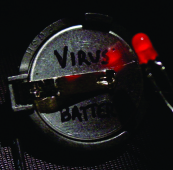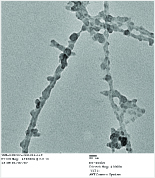Widely used in small electronic devices and in the nascent market for
HEVS (Hybrid Electric Vehicles), lithium ion batteries store more energy
for theirweight, operate at a higher voltage, and hold a charge much
longer thanother rechargeable batteries. As a new approach, Belcher and
Ceder of the MIT MRSEC IRG-I have explored a biological way to create
new charge storage materials for lithium ion batteries by using a virus
as a scaffold totemplate the growth and assembly of nanoscale electrode
materials. The genetically engineered M13 virus (E4 virus)
successfully provided a platform for the growth of the amorphous iron
phosphate, which can be used as a promising positive electrode material
(top image). For electrochemical testing of the obtained amorphous iron
phosphate, silver nano rods, which were also grown on separate E4 virus,
were added as a conducting agent. The preliminary electrochemical data
show that more than 120mAh/g of capacity (theoretical capacity of
FePO4·2H2O is 140mAh/g) can be delivered. A small coin cell battery made
from the virus-grown material powering an LED is shown in the bottom
image. Because of self-replication, virus growth of nanomaterials can be
easily scaled up as an effective way to fabricate novel battery
materials.

Coin cell battery made from virus-grown material.

TEM image of an amorphous iron phosphate nanoparticle grown on a genetically engineered virus template.